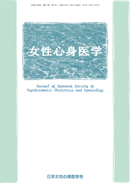Volume 13, Issue 3
Displaying 1-25 of 25 articles from this issue
- |<
- <
- 1
- >
- >|
-
Article type: Cover
2008 Volume 13 Issue 3 Pages Cover1-
Published: November 30, 2008
Released on J-STAGE: January 26, 2017
Download PDF (10920K) -
Article type: Index
2008 Volume 13 Issue 3 Pages Toc1-
Published: November 30, 2008
Released on J-STAGE: January 26, 2017
Download PDF (47K) -
Article type: Article
2008 Volume 13 Issue 3 Pages 103-
Published: November 30, 2008
Released on J-STAGE: January 26, 2017
Download PDF (149K) -
Article type: Appendix
2008 Volume 13 Issue 3 Pages 105-107
Published: November 30, 2008
Released on J-STAGE: January 26, 2017
Download PDF (232K) -
Article type: Appendix
2008 Volume 13 Issue 3 Pages 108-111
Published: November 30, 2008
Released on J-STAGE: January 26, 2017
Download PDF (154K) -
Article type: Appendix
2008 Volume 13 Issue 3 Pages 112-113
Published: November 30, 2008
Released on J-STAGE: January 26, 2017
Download PDF (113K) -
Article type: Article
2008 Volume 13 Issue 3 Pages 115-126
Published: November 30, 2008
Released on J-STAGE: January 26, 2017
Download PDF (1153K) -
Article type: Article
2008 Volume 13 Issue 3 Pages 127-134
Published: November 30, 2008
Released on J-STAGE: January 26, 2017
Download PDF (906K) -
Article type: Article
2008 Volume 13 Issue 3 Pages 135-142
Published: November 30, 2008
Released on J-STAGE: January 26, 2017
Download PDF (843K) -
Article type: Article
2008 Volume 13 Issue 3 Pages 143-152
Published: November 30, 2008
Released on J-STAGE: January 26, 2017
Download PDF (984K) -
Article type: Appendix
2008 Volume 13 Issue 3 Pages 153-154
Published: November 30, 2008
Released on J-STAGE: January 26, 2017
Download PDF (123K) -
Article type: Appendix
2008 Volume 13 Issue 3 Pages 155-156
Published: November 30, 2008
Released on J-STAGE: January 26, 2017
Download PDF (112K) -
Article type: Appendix
2008 Volume 13 Issue 3 Pages 157-158
Published: November 30, 2008
Released on J-STAGE: January 26, 2017
Download PDF (89K) -
Article type: Appendix
2008 Volume 13 Issue 3 Pages 159-160
Published: November 30, 2008
Released on J-STAGE: January 26, 2017
Download PDF (68K) -
Article type: Appendix
2008 Volume 13 Issue 3 Pages 161-
Published: November 30, 2008
Released on J-STAGE: January 26, 2017
Download PDF (50K) -
Article type: Appendix
2008 Volume 13 Issue 3 Pages 162-
Published: November 30, 2008
Released on J-STAGE: January 26, 2017
Download PDF (27K) -
Article type: Appendix
2008 Volume 13 Issue 3 Pages 164-
Published: November 30, 2008
Released on J-STAGE: January 26, 2017
Download PDF (29K) -
Article type: Appendix
2008 Volume 13 Issue 3 Pages 165-166
Published: November 30, 2008
Released on J-STAGE: January 26, 2017
Download PDF (136K) -
Article type: Appendix
2008 Volume 13 Issue 3 Pages 167-
Published: November 30, 2008
Released on J-STAGE: January 26, 2017
Download PDF (94K) -
Article type: Appendix
2008 Volume 13 Issue 3 Pages 168-
Published: November 30, 2008
Released on J-STAGE: January 26, 2017
Download PDF (22K) -
Article type: Appendix
2008 Volume 13 Issue 3 Pages 169-
Published: November 30, 2008
Released on J-STAGE: January 26, 2017
Download PDF (48K) -
Article type: Appendix
2008 Volume 13 Issue 3 Pages 170-
Published: November 30, 2008
Released on J-STAGE: January 26, 2017
Download PDF (59K) -
Article type: Appendix
2008 Volume 13 Issue 3 Pages 170-
Published: November 30, 2008
Released on J-STAGE: January 26, 2017
Download PDF (59K) -
Article type: Appendix
2008 Volume 13 Issue 3 Pages 170-
Published: November 30, 2008
Released on J-STAGE: January 26, 2017
Download PDF (59K) -
Article type: Cover
2008 Volume 13 Issue 3 Pages Cover2-
Published: November 30, 2008
Released on J-STAGE: January 26, 2017
Download PDF (513K)
- |<
- <
- 1
- >
- >|
